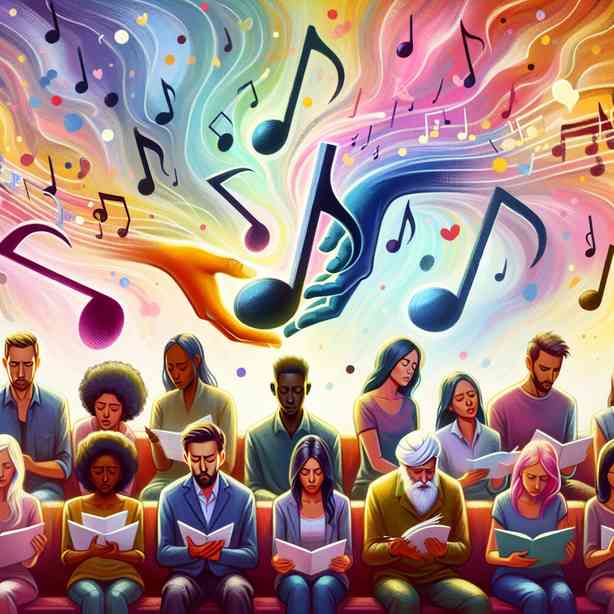
Some songs have a unique ability to evoke emotions that can be both painful and cathartic at the same time. This phenomenon is often referred to as experiencing “beautiful pain.” When we listen to these tracks, we may find ourselves feeling a mix of sadness, nostalgia, and even comfort, all wrapped in the intricate melodies and poignant lyrics. But what is it about certain songs that can hurt us and, paradoxically, make us feel good? This article will explore the psychology behind this emotional response, the elements that contribute to the “good pain,” and recommendations for songs that exemplify this complex relationship between music and emotion.
To begin with, it is essential to understand that music has a profound effect on our emotional state. Studies have shown that listening to music activates several areas of the brain associated with emotion, memory, and even physical sensations. The interaction between melody and lyric can send us reeling through a whirlwind of feelings. When we encounter a song that strikes a chord with our personal experiences, the emotional resonance becomes even more intense. This connection often allows us to confront feelings we may have been suppressing, providing a safe space to explore our vulnerabilities and make sense of our experiences.
The concept of “beautiful pain” is closely tied to the idea of catharsis. Catharsis, derived from Greek tragedy, refers to the process of releasing pent-up emotions through artistic expression. Musicians often channel their own struggles into their work, creating songs that resonate with listeners facing similar challenges. For instance, a song detailing heartbreak may elicit both tears and a sense of relief because it allows listeners to process their own pain. When we hear someone else articulate feelings we have difficulty expressing, we often find solace and a sense of community in shared experiences.
Moreover, the instrumentation and arrangement of a song play a significant role in how it affects our emotions. The combination of major and minor chords, for example, can create a sense of tension and release, reflecting the duality of joy and sorrow. Songs that incorporate minor keys often evoke feelings of melancholy, while a shift to a major key can provide a sense of hope or resolution. This contrast makes the listening experience more dynamic and can lead to an emotional catharsis that, while initially painful, ultimately leaves us feeling uplifted.
One of the most fascinating aspects of songs that cause “good pain” is their ability to shape our memories. Music often serves as a powerful trigger for nostalgia, reminding us of specific moments in our lives. This connection can be bittersweet, as recalling happier times that are now lost can bring forth feelings of longing and sadness. However, reflecting on these memories can also offer comfort, reminding us of the love and joy we’ve experienced in the past. This duality allows us to appreciate our emotional journey and leads us to a greater understanding of ourselves.
In many cases, the emotional impact of a song can also be bolstered by its lyrics. Poets, songwriters, and musicians often draw on personal experiences to craft words that resonate deeply with their audience. The authenticity of such lyrics can evoke empathy and encourage listeners to reflect on their own life struggles. When the lyrics capture an emotional truth, they have the potential to heal and connect. This shared vulnerability is a cornerstone of the “good pain” experience, as it fosters a sense of belonging and understanding among listeners.
In addition, there are biological factors at play that may explain why certain songs can evoke such strong emotional responses. When we listen to music that resonates with us, our brains release neurotransmitters such as dopamine, which are associated with pleasure and reward. This biochemical response can create a sense of euphoria even when the lyrical content is sad or reflective. The juxtaposition of pain and pleasure is intricately woven into our music experiences, often leaving us feeling conflicted yet invigorated.
As we delve deeper into the realm of “good pain” in music, it becomes evident that different genres and styles can elicit these emotions in various ways. For instance, indie and alternative rock often tackle themes of love, loss, and existential struggles, resonating with listeners who appreciate raw and authentic storytelling. On the other hand, classical music might evoke similar emotions through its emotive composition and orchestration, demonstrating that the ability to touch our hearts transcends genres.
To provide some insight into specific songs that exemplify this emotional complexity, let us highlight a few that have resonated with listeners across generations. One timeless example is “Hallelujah” by Leonard Cohen, a song that intertwines themes of love, loss, and redemption through haunting melodies and profound lyrics. The emotional depth of this track allows it to evoke tears while simultaneously offering a sense of spiritual upliftment.
Another song worth mentioning is Adele’s “Someone Like You.” Its powerful exploration of heartbreak and loss connects deeply with listeners who have faced similar experiences. The raw vulnerability in Adele’s voice and the poignant lyrics serve as both a reminder of pain and a path towards healing. Many listeners find that playing this song helps them to process their own emotions, creating a cathartic experience.
In the realm of hip-hop, “Lose Yourself” by Eminem showcases the struggle for perseverance and self-realization, addressing themes of anxiety and determination. While the subject matter is intense, the motivating energy of the track can inspire listeners to confront their challenges, creating that sense of catharsis amid the pain. This balance of emotion makes it an empowering anthem for many.
Ultimately, whether through lyrics, melody, or the experience of nostalgia, certain songs possess the extraordinary ability to encapsulate our sorrows while simultaneously offering comfort and healing. The paradox of “good pain” in music emerges from the complex interplay of human emotion, memory, and the need for connection. These songs not only give voice to our struggles but also foster a sense of shared experience and understanding.
In conclusion, the idea that some songs can hurt in a good way encapsulates the intricate relationship between music and emotion. The ability of music to evoke profound feelings allows us to confront our vulnerabilities, process our experiences, and ultimately find solace and connection. As we navigate through the highs and lows of life, it is often these emotional songs that remind us we are not alone in our struggles. So, the next time you find yourself drawn to a song that resonates with your pain, remember that it may just be a stepping stone in your journey towards healing and self-discovery. Embrace the beautiful pain that music can bring, and allow it to guide you on a path of emotional growth and understanding.


